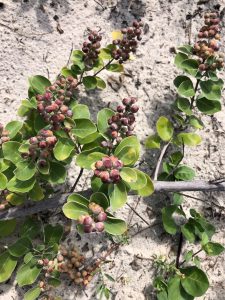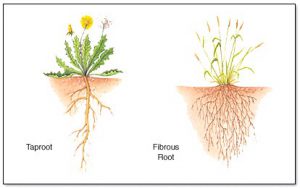Other common names: Roundleaf Chaste tree, Chasteberry, Monk’s Pepper
Florida beach goers, have you strolled alongside coastal dune areas and seen this attractive, vining plant? You may have witnessed the presence of beach vitex (Vitex rotundifolia).

This invasive, noxious weed is native to Asia and parts of Oceania and was first introduced to the southeastern U.S. for dune stabilization, preventing further erosion following the aftermath of Hurricane Hugo in 1989. On the contrary, this plant proved not only an incredibly poor dune stabilizer, but it outcompetes more effective dune stabilizing species, such as our native sea oats (Uniola paniculata).

Beach vitex is low-growing, woody, perennial shrub with quickly spreading branches. Reports have also indicated that this plant can grow upward, reaching heights of nearly 3 feet, taking on more of a bush-like growth habit. Extremely salt and drought tolerant, it thrives on the surface of sandy dune areas. Its opposite, rounded leaves have a slightly spicy aroma when crushed and, unlike other Vitex species present in Florida, have a notable white pubescence on the underside of leaf surfaces.
Blue-violet, funnel-shaped flowers bloom in the Spring, leading to the production of reddish fruits in the Summer. These seeds are easily dispersed after being consumed by birds and other wildlife and may also float away with ocean currents. There’s more! It can also rapidly reproduce and spread via underground vegetative structures.

So, why is this plant so problematic? Well, dune erosion present in areas dominated by beach vitex results from the production of a non-fibrous taproot. Many of our native dune stabilizing species hold our coastal dunes together through their fibrous root systems. Furthermore, this plant actually induces a hydrophobic chemical response in the sand that essentially draws water away from native plants, thereby creating unfavorable conditions for native seeds to germinate and flourish. Even worse, these chemicals can persist in the sandy dunes for up to 3 years.
Apart from the problems caused for our native plant species, sea turtles and their hatchlings, as well as birds, can also become entangled in the dense mats formed by these vines while nesting in coastal dune areas.

Currently classified as a Category I invasive by the Florida Exotic Plant Pest Council (FLEPPC), this additional new classification as a state noxious weed further implies it is illegal to purchase or transport this plant within the state boundaries without proper permitting and that federal authorities have the right to inspect, seize, and destroy products, and quarantine areas, if necessary to contain, or limit the spread of such weeds.
If you suspect you’ve come across beach vitex, please do not try and remove the plant yourself. Instead, reach out to your local county Extension office.
For more information on beach vitex, check out the following resources: FDACS-DPI Pest Alert – Beach Vitex, Florida Plant Atlas, USDA National Invasive Species Information Center: Beach Vitex, CABI Invasive Species Compendium.
 0
0
